Ingredients
 | Some jelly (jello for the Americans amongst you) |  | Chopped fruit of various types including some pineapple or kiwi |
Instructions
Chop various types of fruit into small pieces. We used apple, orange, kiwi, tinned pineapple and fresh pineapple.
Mix up some jelly according to the instructions.
Add the jelly to each fruit in a separate container, and have a further container with just jelly as a control.
Leave in a fridge for a couple of hours to set.
Does all the jelly set properly?
What happens if you use tinned fruit?
Result
You should find that most forms of fruit work well, but fresh pineapple, kiwi fruit and papaya will stop the jelly from setting. However if you use tinned pineapple the jelly will set perfectly.
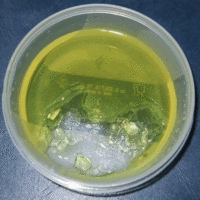 | 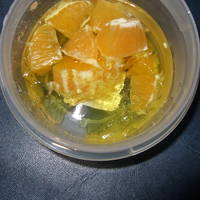 | 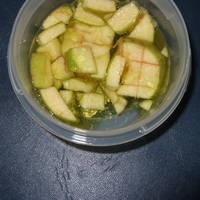 |
| The plain jelly set fine | The orange had no effect | Neither did the apple |
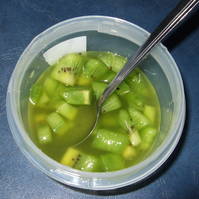 | 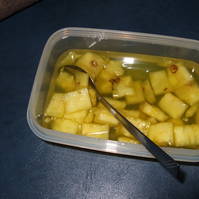 | 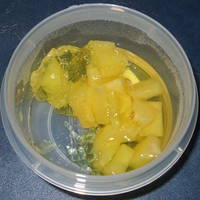 |
| The kiwi fruit jelly wouldn't set... | Neither would the pineapple jelly... | But if you use tinned pineapple it will set fine. |
Explanation
Jelly is made up of long thin protein molecules. The reason that jelly sets is that as the gelatin molecules tangle up as they cool creating a huge intertwined tangle which traps the water and makes a flexible solid.
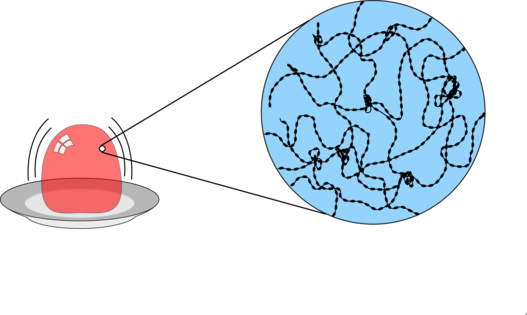 |
| Jelly under a microscope showing the long gelatin protein molecules |
The pineapple contains an enzyme called bromelain and kiwi fruit another enzyme called actinidin - both of these enzymes are proteases, which means that they will chop up protein molecules. In the same way that the digestive enzymes in your intestines break up proteins to allow you to digest them.
This means that when they are mixed with gelatin, the proteases chop the gelatin protein up into pieces which are far too short to tangle, so the jelly doesn't set.
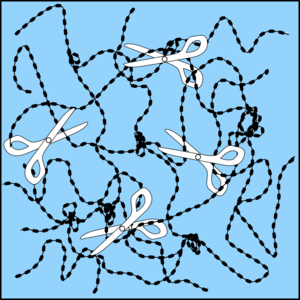 | 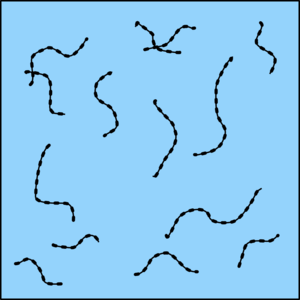 |
| The proteases in pineapple and kiwi fruit chop up the gelatin molecules... | So the pieces are too short to tangle so the jelly doesn't set. |
Why does tinned pineapple make jelly?
In the canning process the pineapple is heated up to kill all the bacteria inside, this means it doesn't decay and can last a long time inside a can. This heat causes the enzymes to 'denature', meaning they lose their structure and cease to act as a protease, so the jelly can still set.
Why do pineapple and kiwifruit have proteases?
All fruits will have some proteases but pineapple and kiwi fruit have far more. Exactly why is not known but it is probably to repel pests. Animals and bacteria are made up of proteins so the proteases will essentially digest any pests that attempt to feed on the fruit.
This is also the reason why your mouth tingles if you eat too much of them. The proteases start to digest the skin of your mouth. But don't worry - in small quantities it is quite harmless!
- Previous Flubber
- Next Drop Magnifier










Comments
i love this experiment!!!
i love this experiment!!! thank you!! deliciois
loved this experiment as much
loved this experiment as much as i love fortnite, fortnite and this experiment saved me from ascending to godhood
Curiously, for the Kiwi and
Curiously, for the Kiwi and Pineapples jellies that didn't set. Is there a way to rescue them? If you then heated them to kill off the enzymes and then refrigerate would the jelly form this time?
Good idea - give it a try and
Good idea - give it a try and tell us what happens!
I LOVE FORTNITE AND THIS
I LOVE THIS WEBSITE BECAUSE IT SAVED ME IN A EXPERIMENT I DID
I loved this experiment as
I loved this experiment as much as Fortnite, Fortnite and this experiment saved me from committing suicide
thank you
thank you
Really helpful for my exam
Really helpful for my exam
waow, what a straightforward
waow, what a straightforward and concise answer! thank you naked scientist!
Your explanation was so easy
Your explanation was so easy to understand. Thank you. Jane
this was very helpul for my h
this was very helpul for my h/w
More things about fresh
More things about fresh pineapple please, it is very important for scientific investigation
Add a comment